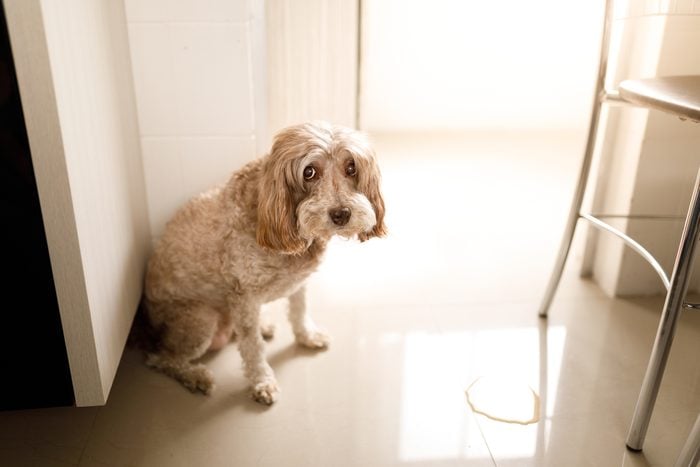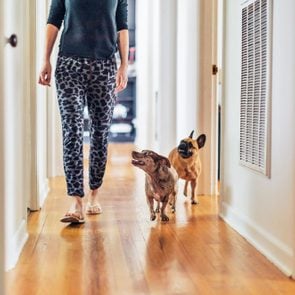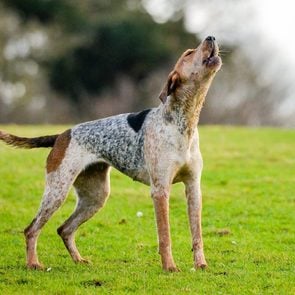How to Stop a Dog from Peeing in the House
Updated: Mar. 05, 2024

A new pup is a joyful addition to the home—one that may need to learn some manners. Here's some expert advice on how to stop a dog from peeing in the house.
If you’re planning to welcome a new dog into your home or have recently done so, you and your family may be anxious to teach him to play fetch, sit for a treat or do some cute dog tricks, like shaking paws or rolling over. Of course, you’ll also want to teach him the basics of puppy training so he avoids jumping on people and socializes well with other dogs (and cats!). But don’t let any of these skills take a backseat to one of the most important aspects of training a dog: figuring out how to stop a dog from peeing in the house.
Teaching a puppy to go potty outside requires time and patience—and maybe some know-how on how to clean dog pee from your carpet. But even an older, already house-trained dog can show behavioral changes and revert to doing his dirty business on your floors instead of outside. It may be a sign that your dog is sick, or it may be due to some change in his routine, including the arrival of a new pet or human baby.
Whether it’s youthful inexperience or some age- or health-related issue that is causing your dog to pee in the house, there’s probably a solution. Here’s a kibble-size bowl full of expert advice on how to stop a dog from peeing in the house.
Get Reader’s Digest’s Read Up newsletter for more pet tips, humor, cleaning, travel, tech and fun facts all week long.
About the experts
|
How often do dogs need to pee each day?
There are no hard-and-fast rules about how long dogs can “hold it,” explains Kristin Wuellner, DVM, a licensed veterinarian with Hill’s Pet Nutrition, and there are no notable differences between house-training male or female puppies.
Your dog’s age doesn’t matter as much as you might think. (In fact, learning how to stop grown dogs from peeing in the house requires the same information as learning how to curb indoor urination in young dogs.) Size is often more of a determining factor. “Due to a larger bladder size, most larger breeds have a greater capacity to wait than smaller breeds,” she says.
Traci Madson, a certified dog trainer with Pupford, agrees. “Generally, smaller dogs will need to go more frequently than larger dogs, and puppies should be taken out for pee breaks more than adult dogs,” she says, noting that new puppies will need to go outside to go potty every 45 to 90 minutes, which will then extend to every 1.5 to 3 hours as your puppy grows. “Dogs generally gain a mature bladder by about 5 to 6 months old, and a good indicator of being fully potty-trained is if your pup hasn’t had an accident inside for a full month straight.”
Dr. Wuellner adds that by the time puppies are 7 months old, most can wait seven or more hours to go to the bathroom (a good thing if you’re leaving your dog home alone). “And by that age,” she says, “they should be able to signal to owners when they need to go.”
Why does my dog keep peeing inside?
If your puppy or adult dog isn’t getting the hang of this whole house-training thing, it’s probably not because he’s trying to be a brat. And it’s not necessarily because you’re dealing with one of the harder dog breeds to train. A dog peeing in the house can be a reaction to external factors, a result of poor training or even due to an underlying health issue. “There are several possible reasons your dog might be going inside,” says Dr. Wuellner, “and often there’s an underlying cause that has nothing to do with bad behavior.”
After weeks of house-training, are you still pulling out your hair and asking “Why is my dog peeing in the house?!” Deep breath. If you can’t isolate the problem yourself, Dr. Wuellner recommends taking your dog to the veterinarian to sleuth out the reason.
Here are a few factors that may cause your furry friend to make poor potty choices:
Ineffective house-training
Some dogs are easier to train than others, but the quality of house-training matters too. “It could be that your dog simply hasn’t been adequately house-trained,” says Dr. Wuellner.
It’s easy to underestimate the time and dedication required to train a pet—especially a puppy—to do its business outside, especially if work or school schedules mean the animal is left alone for long periods of time.
Lack of neutering
Peeing to mark territory is common with non-neutered male dogs, says Dr. Wuellner. It’s a bad habit that often resolves itself once the dog is neutered. But the behavior can resurface. “Neutered males and spayed females may engage in this behavior from time to time,” she says, “especially if they feel threatened by the arrival of another pet.”
Psychological issues
Doggy anxiety, fear, over-excitement or submission may all cause a dog to pee in the house, says Dr. Wuellner. If you think your pet may be experiencing these symptoms, consult with your veterinarian. Dr. Wuellner says there are many options to help manage these behaviors, including nutrition changes.
Medical issues
If your otherwise properly house-trained and well-adjusted dog suddenly starts having accidents in the house, it may be tied to his health. Madson says the only way to truly know if this is a medical issue is by consulting your vet.
“If you’re seeing frequent accidents with a previously potty-trained dog, then the first thing to do is send them to their veterinarian to rule out a medical problem or UTI,” she says. “The vet will take a urine sample and determine if the dog has some medical issue going on that could contribute to the dog having a lot of accidents. If the test comes back normal, then there is a behavioral issue that will need to be addressed.”
How to stop a dog from peeing in the house
Consistency in all aspects of your dog’s or puppy’s routine is one of the surest ways to help them get the hang of peeing outside. “Putting your puppy on a daily feeding schedule will regulate his digestion and make house-training easier for both of you,” adds Dr. Wuellner, who also offers these house-training tips:
Create a consistent schedule
“Your puppy’s feeding schedule should stay as regulated as possible, especially when he’s very young,” says Dr. Wuellner. “Many dogs produce a bowel movement within 30 minutes of a meal.”
As she explains, feeding your dog meals and snacks at specific times, then bringing him to a designated spot right afterward, will set the expectation for him to go after he finishes eating.
Watch the water bowl
If your dog is a heavy water drinker, chances are he’ll need to urinate frequently. So keep an eye on that water bowl. “To rule out any accidents,” says Dr. Wuellner, “take your puppy out shortly after drinking during the puppy-potty-training phase so they’re in the right place at the right time.”
Pay attention to nutritional needs
If you’ve adopted a new puppy or adult dog, you’ll want to take him to the vet and establish his nutritional needs based on his health, breed, rate of growth and more, says Dr. Wuellner. “Paying close attention to your puppy’s ever-changing nutritional needs is one of the most essential ways to keep him on track to not only have a consistent feeding schedule but also to lead a healthy life.”
Depending on what the veterinarian says, that may include specially formulated puppy food or dog food formulated for his specific age and health needs.
Clean up messes
Want to know how to stop a dog from peeing in the house? Clean up after your pup, and don’t do a rush job. If you don’t thoroughly clean after your dog has had an accident indoors, you risk that location becoming his go-to spot because it’s nice and smelly from urine.
Use an enzymatic pet-stain remover tough enough to eliminate, rather than cover, the pee odor. Nature’s Miracle makes a highly rated cleaner for carpets and hardwood floors.
Praise and reward him
When your pup does his good-boy business outside, make sure you shower him with lots of praise and reward him with a little dog treat. Madson says that “the window to reward or punish—which I never recommend doing—your dog after a behavior is five to 10 seconds, so any act beyond this time wouldn’t be connected in your pup’s mind to the accident.”
What not to do when your dog is peeing in the house
The two key things to remember when house-training a dog are patience and positive reinforcement, says Dr. Wuellner. “It’s important to always reward the desired behaviors,” she says. “House-training can take several weeks to months for puppies to learn, so it’s important to stay committed to the process.”
Stock up on washable dog pee pads and a UV flashlight that’ll detect your four-legged friend’s accidents. Then settle in for an extended training period.
Keep in mind, there are a few things you definitely don’t want to do when learning how to stop a dog from peeing in the house. According to the American Humane Society, tops among them are:
Stop training too soon
Puppy and dog house-training is exhausting, so it’s tempting to celebrate your and your dog’s success prematurely. The American Humane Society recommends continuing your training routine for several months—until your pet can go a few months without an accident.
Dr. Wuellner recommends “continuing positive reinforcement of house-training behaviors and incentives for at least one month beyond when you think your puppy is consistently asking to be let outside.”
Punish your puppy
We’ll say it again: House-training has to be a positive experience. Yelling at or threatening your pet is a major puppy-training mistake—it’s just going to scare him into finding a hidden place to pee in the house.
Your dog isn’t peeing inside to get back at you—he’s doing it because he still doesn’t know better, he’s not getting outside often enough or he has a health issue that he can’t explain to you. Consistency, patience and kindness are your and your dog’s best friends during this phase of his life.
Want to learn more about the weird quirks and funny habits of your pets? Dr. Phur on The Pet Collective is a seasoned doggy doctor serving up inside information plus the best tips and tricks for the care of all your animal friends.
Why trust us
At Reader’s Digest, we’re committed to producing high-quality content by writers with expertise and experience in their field in consultation with relevant, qualified experts. We rely on reputable primary sources, including government and professional organizations and academic institutions as well as our writers’ personal experience where appropriate. We verify all facts and data, back them with credible sourcing, and revisit them over time to ensure they remain accurate and up to date. Read more about our team, our contributors and our editorial policies.
Sources:
- Kristin Wuellner, DVM, licensed veterinarian with Hill’s Pet Nutrition.
- Traci Madson, certified dog trainer with Pupford.
- American Humane Society: “Housetraining Puppies & Dogs”



